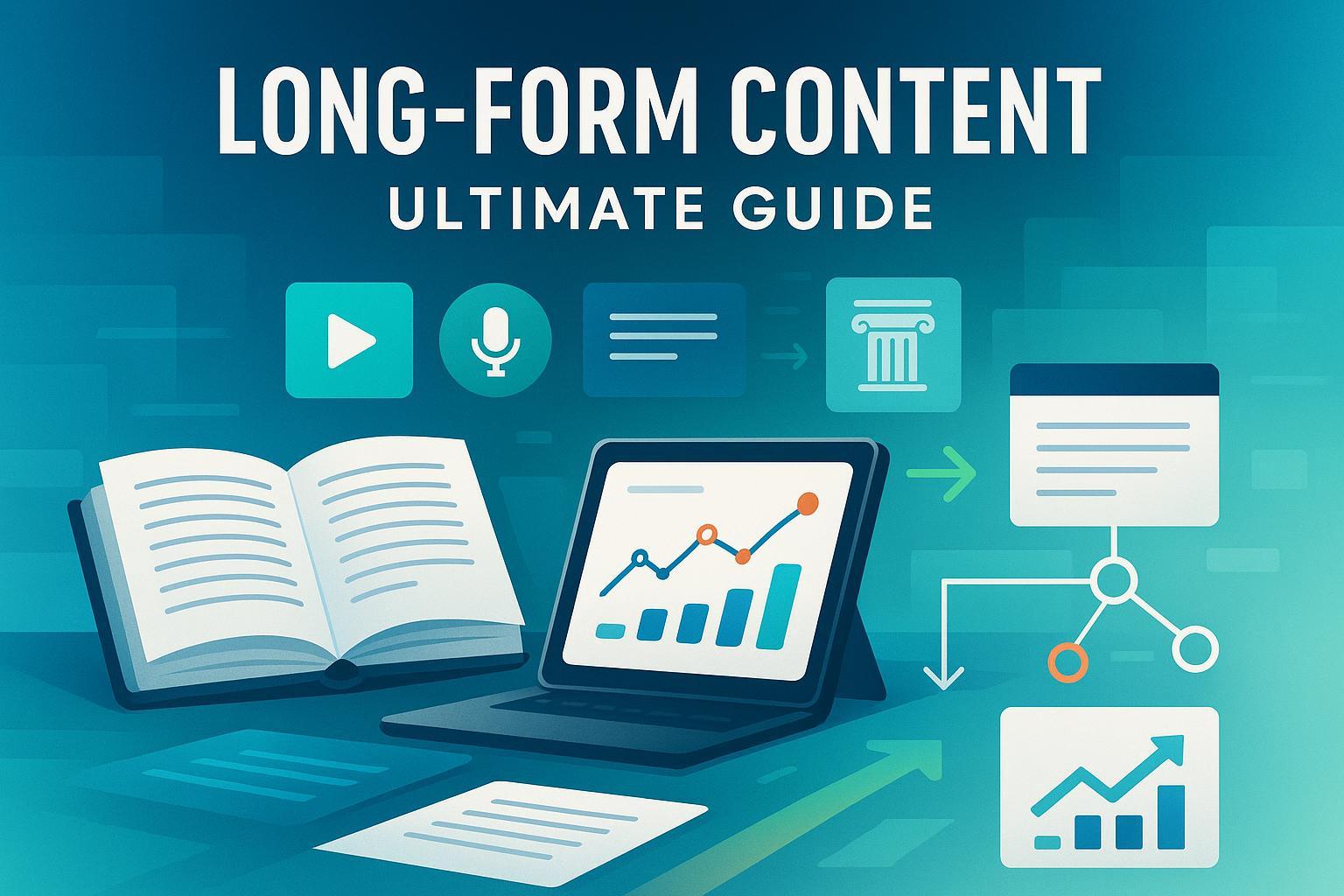Long-Form Content Ultimate Guide: Strategy & Best Practices
Discover the most comprehensive Long-Form Content Ultimate Guide—strategy, SEO, formats, tools, and actionable templates. Master long-form content today!


Table of Contents
1. Introduction to Long-Form Content
Long-form content has emerged as the powerhouse of modern content marketing, driving authority, SEO performance, and deep audience engagement. Defined as content pieces exceeding 1,000 words—often spanning 3,000 to 10,000+ words (or the multimedia equivalent)—long-form goes far beyond superficial overviews. It delivers comprehensive insight, reliable education, and actionable value.
1.1 What is Long-Form Content?
Definition: Any in-depth asset—article, guide, eBook, whitepaper, video, podcast, webinar—focused on exhaustive coverage of a topic, typically above 1,000–2,500 words (Network Solutions).
Purpose: To answer user intent thoroughly, demonstrate expertise, and nurture trust through well-organized, detailed, and authoritative information (Mailchimp).
1.2 Historical Evolution
Originally, digital content focused on brevity and frequent updates. However, trends have shifted—marketers adopting long-form content rose from 22% (2022) to 42% (2023) as both search engines and audiences rewarded depth and utility (Content Marketing Institute, 2024). Video and multimedia long-form formats now rival traditional articles in reach and impact.
1.3 Relevance in the Modern Marketing Landscape
Long-form is the strategic backbone of B2B, SaaS, and brand-driven marketing.
Investments in content marketing are projected to reach $564.8B globally by 2025 (Statista).
Increasingly, brands prioritize “content hubs,” interactive mega-guides, and multimedia storytelling to build credibility and drive sustained growth.
2. Benefits and Strategic Value
Why invest in long-form content? The data and market trends are compelling:
2.1 SEO Advantages
Higher Rankings: Content exceeding 3,000 words acquires 77% more backlinks and ranks 56% higher than sub-1,000 word assets (Backlinko, 2023).
Dwell Time: Longer, more detailed posts increase session duration, reducing bounce rates and signaling value to search engines.
FAQ & Snippet Potential: Well-structured long-form can win rich search features like Google’s featured snippets and FAQ boxes.
2.2 Authority & Trust Building
Thought Leadership: In-depth guides and whitepapers are trusted anchors for brand and personal authority.
Expert Recognition: Well-researched content with citations, data, and expert commentary attracts professional shares and backlinks.
2.3 Engagement & Conversion
Shareability: Long-form articles are shared 24% more than shorter ones (BuzzSumo).
Higher Conversions: Detailed, story-driven content excels at nurturing users through the funnel—enabling education, objection handling, and personalized calls-to-action within a single asset.
2.4 Long-Term Compounding Returns
Evergreen long-form pieces generate steady search, social, and referral traffic for years, especially when updated regularly.
2.5 Measurable ROI
Brands running long-form campaigns report lasting organic growth, improved lead quality, and compounding authority.
According to Content Marketing Institute (2024), 46% of B2B marketers will boost long-form content budgets in 2025 in direct response to proven ROI.
3. Types and Formats of Long-Form Content
Long-form isn’t just about word count—it’s about strategic format selection, cross-medium storytelling, and meeting varying audience preferences.
3.1 Written Content
Ultimate Guides & Pillar Posts: Exhaustive, reference-style articles designed as one-stop resources.
Case Studies: Deep-dive success/failure narratives showcasing processes and outcomes.
eBooks & Whitepapers: Downloadable, intricate analysis or best-practice playbooks for lead generation and education.
3.2 Multimedia Content
Long-Form Video: Webinars, documentaries, or lesson-series (typically 20+ minutes) featuring visual education, storytelling, or Q&A.
Podcasts: Serial or standalone deep dives—interviews, thought leadership, and investigative narratives.
Webinars/Workshops: Live or evergreen educational sessions offering interactivity, hands-on learning, and Q&A.
3.3 Hybrid and Interactive Formats
Content Hubs: Curated resource centers linking multiple long-form assets and interactive tools.
Interactive Content: Quizzes, calculators, flowcharts, and immersive guides that combine instruction with participation.
Pro Tip: Blend formats (e.g., video + article transcription + audio summary) for maximal reach across audience segments.
See Table: Long-Form Content Formats & Use Cases
4. Long-Form vs. Short-Form Content: A Comparative Analysis
Feature | Long-Form Content | Short-Form Content |
|---|---|---|
Length | 1,000–10,000+ words (20+ min video) | 50–1,000 words (1–5 min video) |
Purpose | Authority, depth, education | Quick info, viral reach, trends |
SEO | High (backlinks, dwell, snippets) | Moderate to low |
Engagement | Sustained, deep | Instant, fleeting |
Conversion | Lead gen, funnel building | CTA, flash sales, basic awareness |
Durability | Evergreen, compounding | Timely, perishable |
Resource Intensity | High (research, visuals, editing) | Low (fast, reactive) |
When to Use Each?
Long-Form: Complex topics, pillar content, perennial resources, inbound lead generation, and SEO authority plays.
Short-Form: Announcements, trends, daily engagement, real-time campaigns, social teasers.
Integrated Approach
Best-in-class programs use both—short-form for velocity and audience warming, long-form for depth, loyalty, and search anchor.
5. Step-by-Step: Creating Impactful Long-Form Content
Modern long-form content combines strategic planning, deep research, workflow discipline, and creative execution. Here’s a detailed workflow designed for teams or solo creators:
5.1 Topic Selection & Audience Research
User Intent Mapping: Use tools like SEMrush, Google Trends, and BuzzSumo to identify audience questions, pain points, and trending subjects.
Competitor Gap Analysis: Audit top SERP results. Identify angles, depth, and examples missing from their coverage.
Keyword Research: Find short-tail and long-tail phrases with strong volume and clear search intent (See SEMrush Keyword Tools).
5.2 Outlining & Planning
Create a Clear Structure: Use proven templates (see downloadable outline), including:
Executive summary/introduction
Sectional deep-dives with subtopics
Visuals and case study inserts
Summaries and actionable takeaways per section
Editorial Calendar: Plan publication dates, update cycles, and responsibilities using ClickUp, Trello, or Asana templates.
5.3 In-Depth Research
Authoritative Sources: Gather studies, expert insights, industry benchmarks, customer interviews, and original data.
Reference & Cite Everything: Use Harvard/APA citation style for external data. Link to original sources where possible.
5.4 Writing & Formatting
Introduction: Set reader expectations, stress authority, and outline benefits.
Accessible Sections: Use H2/H3 headings, short paragraphs, lists, and call-outs for complex information.
Integrate Visuals: Charts, infographics, diagrams, screenshots, and video/audio embeds maximize engagement and clarity.
Storytelling & Case Studies: Weave narratives, challenges, data, and real-world lessons throughout.
5.5 Optimization & Review
SEO On-Page Tactics: Naturally weave in primary/secondary keywords in headings, metadata, and image alt text.
Internal/External Linking: Cross-reference related guides, pillar posts, and authoritative external content.
Fact-Checking & Editing: Use tools like Grammarly, ProWritingAid, and Hemingway for clarity, tone, and grammatical precision.
Collaborative Review: Seek peer/editorial feedback for gaps or improvement.
5.6 Design, Interactivity & Accessibility
Professional Visual Design: Custom graphics, interactive tables, clickable CTAs.
Accessibility: Alt text for images, high-contrast visuals, and readable fonts. Consider audio summaries or video transcriptions.
5.7 Publication & Launch
Platform Optimization: Post on fast, mobile-friendly CMS platforms. Apply schema markup (Article, FAQ).
Early Promotion: Email teasers, social shares, influencer outreach, and repurposed micro-content.
Download: Long-Form Content Planning and Workflow Checklist (PDF)
Template: Editorial Calendar for Content Teams (Google Sheet)
6. Promotion, Distribution, and Measurement
Production is only half the battle—success depends on strategic distribution and continuous measurement.
6.1 Distribution Channels
Owned Media: Blog, website resource center, newsletter.
Earned Media: Guest posts, PR pitches, influencer shares, link-building outreach.
Paid Media: Native ads, content syndication networks, sponsored posts (LinkedIn, Facebook, industry portals).
Repurposing: Break guide into threads for Twitter/X, LinkedIn carousels, short-form video for TikTok/YouTube Shorts, podcast snippets, infographics for Pinterest or Instagram.
6.2 Advanced Promotion Techniques (2024 & Beyond)
AI-Powered Outreach: Use AI to segment audiences and personalize outreach.
Community-Led Promotion: Reddit AMAs, Slack group shares, LinkedIn discussion boards.
Webinar or Panel Launches: Kick off with a live discussion event to drive initial traffic.
6.3 Measurement & KPIs
Traffic Metrics: Sessions, unique visits, organic vs. referral split (Google Analytics, Plausible, Fathom).
Engagement: Average time on page, scroll depth, interactivity rates (via Hotjar, Crazy Egg).
SEO: Keyword rankings, backlink growth (Ahrefs, SEMrush).
Conversion: CTA click-through, downloads, demo requests, lead gen forms.
Attribution: Model influence on pipeline, revenue, or customer activation via UTM tracking and CRM integration.
Template: Long-Form Content Performance Dashboard (Google Sheet)
6.4 Optimization & Continuous Improvement
Historical Optimization: Quarterly content reviews, data refreshes, and structural updates.
A/B Testing: Try different CTAs, lead magnets, intro hooks, and visual formats.
7. Trends, Tools, and Essential Resources
7.1 2024–2025 Trends in Long-Form Content
AI-Driven Creation: Generative AI significantly accelerates outlining, drafting, and editing workflows, especially for ideation and repurposing (CMI, 2024).
Video & Podcast Dominance: Long videos (20+ min) and series-based podcasts are prioritized by both platforms and users.
Interactive Experiences: Calculators, quizzes, and rich multimedia are standing out in crowded markets.
Personalization: Behavioral and intent-based content branching creates bespoke journeys.
7.2 Toolkits & Templates
Writing & Editing: Grammarly, ProWritingAid
Content Analytics: Google Analytics, Hotjar
Master Toolkit: Downloadable Templates & Process Documents
7.3 Recommended Readings & References
8. Case Studies & Practical Examples
8.1 B2B SaaS: The SEO Pillar Guide
A SaaS provider created a 7,500-word resource hub and saw keyword rankings for target terms rise from #24 to #3 in under six months. Organic leads doubled. Keys to success: superior depth, visual navigation, and regular content updates.
8.2 Media Publisher: Podcast + Blog Fusion
A major publisher embedded audio interviews and video highlights into its 5,000-word ultimate guide, increasing time-on-page by 22% and social shares by 200% versus written-only pieces.
8.3 eCommerce: Interactive Whitepaper
An eCommerce brand used an interactive, data-rich whitepaper (with embedded calculators and infographics) for B2B lead generation. Result: 10x more qualified leads and multiple industry backlinks following a launch webinar.
8.4 Common Pitfalls and Fixes
Pitfall: Overwhelming readers with jargon and unnecessary detail.
Solution: Use reader personas, plain language, and summary boxes. Break dense topics with visuals and relatable stories.
Pitfall: Failing to update or promote after publication.
Solution: Block quarterly “update cycles” in your editorial calendar; repurpose content for new channels and fresh audiences.
See: More Case Study Snapshots (Downloadable)
9. FAQ & Additional Resources
9.1 Frequently Asked Questions
Q: What is the minimum word count for long-form content?
Industry best practice starts at 1,000 words, but top-performing pieces are usually 3,000–10,000+ words (CMI).
Q: Does long-form always outperform short-form?
No, but for complex topics, SEO, and compounding brand value, long-form clearly wins. Short-form is ideal for real-time and awareness plays.
Q: Is video content considered long-form?
Yes! Long videos, webinars, and podcasts are growing in strategic value—often outperforming text-only guides in engagement.
Q: How often should you update long-form content?
Every 6–12 months or as often as industry data/trends change. Set regular "historical optimization" reviews (SEMrush Guide).
Q: What tools accelerate workflow and quality?
AI writing software (for drafts/repurposing), editorial templates, curation tools (Feedly, Pocket), project managers (ClickUp, Asana), and analytics/SEO platforms; see Toolkit Section.
9.2 Glossary
Pillar Content: A comprehensive resource that anchors topic authority.
Content Hub: A centralized repository linking related resources.
Historical Optimization: Periodic updates to keep content fresh and ranking.
Interactive Content: Content elements that require or respond to user actions (quizzes, calculators).
9.3 Further Reading & Links
10. Conclusion & Actionable Checklist
10.1 Key Takeaways
Long-form content is the standard-bearer for authority, SEO, and high-value engagement in digital marketing.
Success relies on clear structure, discipline across research and workflow, data-driven optimization, and integrated multimedia execution.
Ongoing updates, cross-channel promotion, and a rigorous measurement framework are non-negotiable.
10.2 Actionable Checklist
Define target audience, user intent, and research needs
Map and analyze top competing content
Select topics and keywords based on data
Build a detailed outline and assemble resources
Draft in sections, insert visuals, case studies, and CTAs
Optimize for SEO and accessibility
Peer-review and edit for clarity, completeness, and engagement
Publish on a fast, search-friendly CMS
Execute a multi-channel promotion plan
Measure against traffic, engagement, and conversion KPIs
Update quarterly and repurpose for new formats
Ready to define your niche, grow your organic pipeline, and build enduring authority? Start planning your next long-form masterpiece today — and download all the templates, checklists, and case studies linked above!
This Ultimate Guide leverages industry best practices, up-to-date research, and practical tools. For ongoing updates, new templates, and thought leadership, bookmark this page and revisit regularly.





